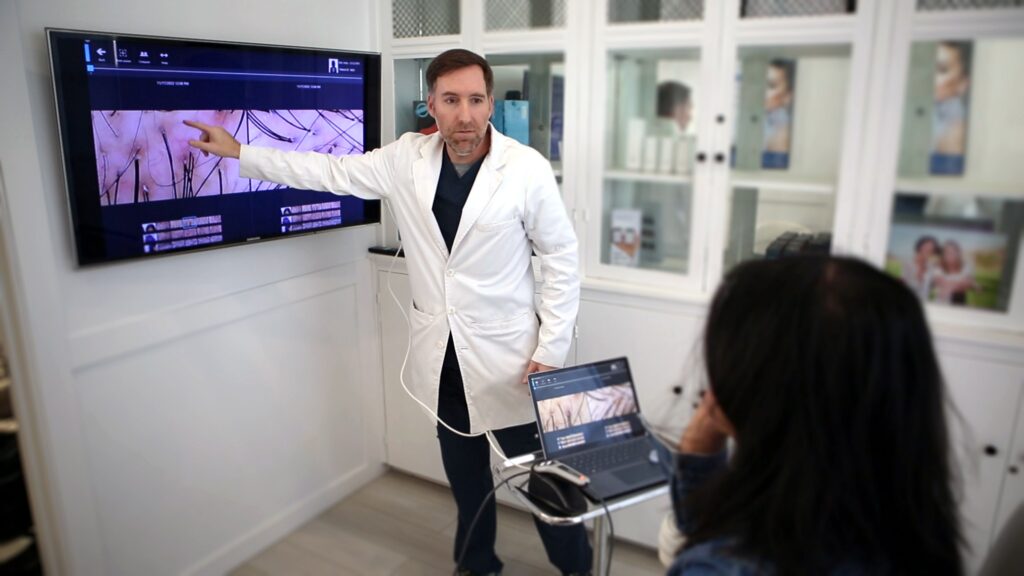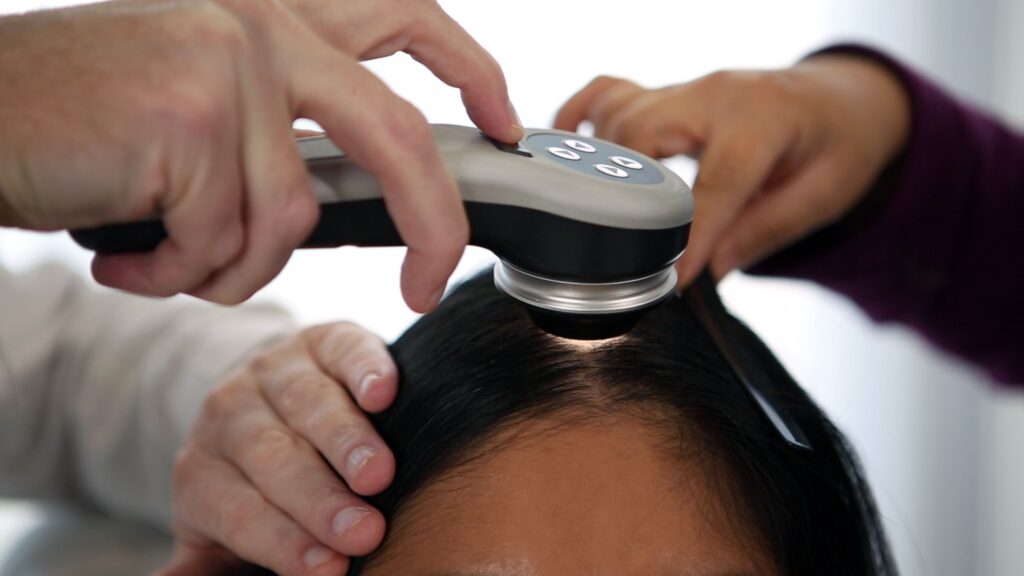Hair loss can be a distressing and confusing experience for many. Whether it’s sudden or gradual, understanding the cause of hair thinning or balding is the first step toward finding an effective treatment. One of the most advanced and accurate methods used by dermatologists and hair loss specialists to diagnose the underlying causes of hair loss is Trichoscopy. In this blog, we’ll dive into what Trichoscopy is, why it’s considered the gold standard for hair loss diagnosis, and how it can guide you toward the right treatment.
What Is Trichoscopy?
Trichoscopy is a non-invasive diagnostic procedure that uses a specialized tool called a dermatoscope to examine the scalp and hair follicles in high definition. This tool magnifies the hair and scalp, allowing the doctor to identify signs of hair loss and determine its cause. Unlike traditional scalp examination, Trichoscopy gives detailed insight into the condition of hair follicles, scalp health, and the hair growth cycle, enabling a much more precise diagnosis.
Why Is Trichoscopy the Gold Standard?
There are several reasons why Trichoscopy has earned its place as the gold standard for diagnosing hair loss. Here are a few key factors:
Non-Invasive and Quick
Unlike biopsies or blood tests, Trichoscopy is a quick, non-invasive procedure that can be done in-office during a regular consultation. It requires no recovery time, and you can continue with your day immediately afterward. This makes it an ideal choice for those seeking a fast and effective diagnosis.Detailed Visualization
The dermatoscope magnifies the scalp and hair follicles, offering a high-resolution view that can reveal key signs of hair loss, such as miniaturized hair follicles, inflammation, and abnormalities in the hair growth cycle. It can also detect early signs of conditions like androgenic alopecia (pattern baldness), alopecia areata, and telogen effluvium (temporary hair shedding), which might not be visible to the naked eye.Accurate Diagnosis
Trichoscopy allows for a detailed and accurate diagnosis of the underlying cause of hair loss. By examining the patterns, density, and distribution of hair follicles, specialists can identify conditions that may be difficult to diagnose through visual inspection alone. This level of accuracy helps doctors make informed decisions about the best course of treatment for each individual patient.Real-Time Monitoring
Another advantage of Trichoscopy is its ability to track the progression of hair loss over time. By performing Trichoscopy at different stages of treatment, doctors can monitor the effectiveness of therapies like PRP (Platelet-Rich Plasma), topical treatments, or medications, and adjust the treatment plan accordingly.
Common Conditions Diagnosed with Trichoscopy
Trichoscopy is particularly useful for diagnosing a variety of hair loss conditions, including:
- Androgenic Alopecia (Pattern Baldness): The most common cause of hair loss in both men and women. Trichoscopy can reveal miniaturized hair follicles, which are indicative of this condition.
- Alopecia Areata: An autoimmune condition that causes round patches of hair loss. Trichoscopy can detect a characteristic sign known as “exclamation point hairs,” which are short, broken hairs that taper at the base.
- Telogen Effluvium: A condition characterized by temporary hair shedding due to stress, hormonal changes, or illness. Trichoscopy can identify an increased number of hairs in the resting (telogen) phase of the hair growth cycle.
- Scalp Infections: Trichoscopy can also help identify scalp conditions such as fungal infections or seborrheic dermatitis, which may contribute to hair loss.
The Role of Trichoscopy in Treatment
Once your hair loss diagnosis is confirmed, Trichoscopy plays a crucial role in guiding the most appropriate treatment plan. It helps specialists tailor treatments based on the specific cause of hair loss, ensuring the most effective approach for each individual.
For example, if Trichoscopy reveals androgenic alopecia, treatments like PRP therapy, medications (finasteride or minoxidil), or hair transplant surgery may be recommended. If the cause is telogen effluvium, stress management, dietary adjustments, or lifestyle changes might be suggested. The detailed insights gained from Trichoscopy allow for a more personalized and targeted treatment approach.
How RejuvLA Uses Trichoscopy
At RejuvLA, we understand the emotional and physical toll that hair loss can take. That’s why we offer state-of-the-art diagnostic tools like Trichoscopy as part of our comprehensive hair restoration services. Our specialists use Trichoscopy to provide you with an in-depth understanding of your hair and scalp health, ensuring that you receive the best possible care tailored to your unique needs.
Whether you’re looking to identify the cause of your hair loss or monitoring the progress of an ongoing treatment, Trichoscopy gives us the tools to guide you every step of the way. And with treatments like PRP with Acell, FUE hair transplants, and more, we offer the latest, most effective solutions to help restore your hair and confidence.
Conclusion
Trichoscopy is a game-changer when it comes to diagnosing hair loss. Its ability to provide a detailed, accurate, and non-invasive assessment of your hair and scalp sets it apart as the gold standard for hair loss diagnosis. At RejuvLA, we use this advanced tool to ensure that each patient receives a personalized treatment plan based on a precise understanding of their unique condition.
If you’re experiencing hair loss or thinning, don’t wait to seek help. Schedule a consultation with our specialists at RejuvLA today, and let us guide you on your journey to healthier, fuller hair.


